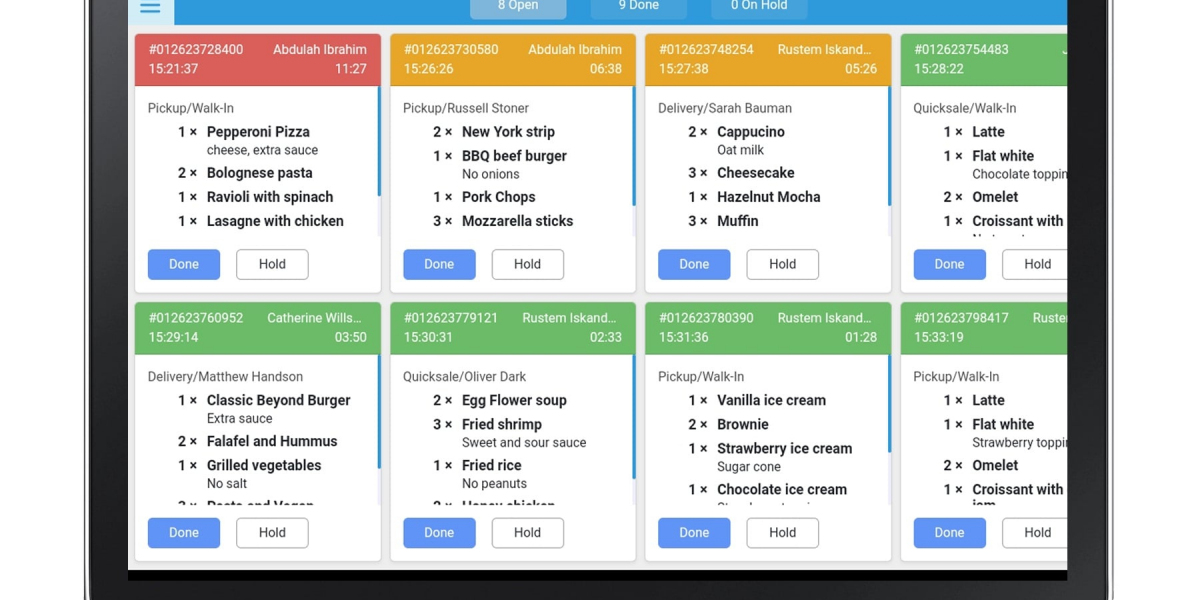Introduction
In the fast-paced world of culinary arts, precision and speed are paramount. The introduction of Restaurant Kitchen Display Systems has revolutionized the way kitchens operate, bringing efficiency and organization to the forefront. Let's delve into the intricacies of this technological marvel.
What is a Restaurant Kitchen Display System?
A Restaurant Kitchen Display System (KDS) is a digital solution designed to streamline order management and communication in a restaurant kitchen. It replaces traditional paper tickets with digital displays, providing real-time updates and enhancing operational efficiency.
Evolution of Kitchen Display Systems
Restaurant Kitchen Display Systems have come a long way since their inception. From basic digital screens to sophisticated integrated platforms, the evolution has been remarkable. Today's KDS incorporates advanced features like order prioritization, customization options, and seamless integration with Point of Sale (POS) systems.
Importance of Restaurant Kitchen Display Systems
Efficiency in Order Management
The primary function of a Kitchen Display System is to streamline order management. By digitizing orders and displaying them in real-time, KDS ensures that chefs can prioritize tasks effectively, reducing wait times and improving customer satisfaction.
Enhanced Communication
Effective communication is the backbone of any successful kitchen operation. KDS facilitates seamless communication between front-of-house staff and kitchen personnel, eliminating errors and ensuring that orders are prepared accurately.
Streamlined Workflow
By centralizing order information and automating processes, KDS helps streamline the workflow in busy kitchens. Chefs can focus on cooking, while the system manages order routing and timing, resulting in smoother operations during peak hours.
Components of a Kitchen Display System
Display Monitors
Display monitors serve as the interface between kitchen staff and incoming orders. These high-resolution screens are strategically placed in the kitchen, ensuring that chefs have clear visibility of order details and special instructions.
Order Management Software
The backbone of any KDS is its order management software. This software interprets incoming orders, organizes them based on priority, and communicates with kitchen staff in real-time. Advanced algorithms ensure that orders are routed efficiently, minimizing bottlenecks.
Integration with POS Systems
For seamless operations, KDS must integrate seamlessly with Point of Sale (POS) systems. This integration allows for automatic order transmission from the front-of-house to the kitchen, reducing manual errors and accelerating order processing.
Benefits of Using a Kitchen Display System
Improved Accuracy
By eliminating handwritten tickets and verbal communication, KDS significantly reduces the risk of errors in order preparation. Chefs receive clear, legible instructions directly on their screens, resulting in consistently accurate dishes.
Faster Service
With KDS, orders are transmitted instantly from the point of sale to the kitchen, reducing wait times for customers. Chefs can prioritize tasks based on order urgency, ensuring that meals are prepared and served promptly.
Real-time Updates
One of the key advantages of KDS is its ability to provide real-time updates on order status. Chefs can monitor the progress of each order, track cooking times, and make adjustments as needed, ensuring timely delivery to customers.
Challenges Faced with Kitchen Display Systems
Technical Glitches
Like any technology, KDS is susceptible to technical glitches and downtime. Hardware malfunctions or software bugs can disrupt kitchen operations, leading to delays and customer dissatisfaction.
Staff Training
Implementing a new KDS requires thorough staff training to ensure smooth adoption and operation. Some kitchen staff may be resistant to change or unfamiliar with digital technology, necessitating comprehensive training programs.
Customization Issues
While KDS offers many customization options, configuring the system to suit specific kitchen workflows can be challenging. Poorly optimized settings or inadequate customization can hinder efficiency and lead to operational bottlenecks.
How to Choose the Right Kitchen Display System
Scalability
When selecting a KDS, consider the scalability of the system to accommodate future growth. Choose a solution that can adapt to changing business needs and expand seamlessly as your restaurant grows.
Compatibility
Ensure that the KDS is compatible with your existing POS system and other hardware components. Seamless integration is essential for smooth operations and efficient order management.
User-Friendly Interface
Opt for a KDS with an intuitive, user-friendly interface that requires minimal training for kitchen staff. Clear navigation, customizable settings, and responsive design are key features to look for.
Customer Support
Select a KDS provider that offers reliable customer support and ongoing maintenance services. Prompt technical assistance and regular software updates are essential for maximizing system uptime and performance.
Implementation Best Practices
Staff Training
Invest in comprehensive staff training to ensure that all kitchen personnel are proficient in using the KDS. Hands-on training sessions, instructional manuals, and refresher courses can help minimize downtime and optimize system utilization.
Regular Maintenance
Schedule regular maintenance checks and software updates to keep the KDS running smoothly. Proactive maintenance can prevent hardware failures and software glitches, minimizing disruptions to kitchen operations.
Feedback Integration
Encourage feedback from kitchen staff regarding the usability and effectiveness of the KDS. Incorporate their suggestions for improvements and updates to optimize system performance and enhance user satisfaction.
Future Trends in Kitchen Display Systems
AI Integration
The future of KDS lies in artificial intelligence (AI) integration. AI-powered algorithms can analyze past order data, predict demand trends, and optimize kitchen workflows for maximum efficiency.
IoT Connectivity
With the Internet of Things (IoT) technology, KDS can communicate with other kitchen appliances and devices in real-time. Connected kitchens enable automated processes, remote monitoring, and proactive maintenance.
Enhanced Analytics
Advanced analytics capabilities allow KDS to generate actionable insights into kitchen performance, order trends, and customer preferences. By leveraging data analytics, restaurants can make informed decisions to improve operational efficiency and enhance the dining experience.
Conclusion
Enhancing Kitchen Efficiency with Modern Technology
Restaurant Kitchen Display Systems have emerged as indispensable tools for modern kitchens, revolutionizing order management and workflow optimization. By investing in the right KDS and implementing best practices, restaurants can achieve greater efficiency, accuracy, and customer satisfaction in their culinary operations.
FAQs
How does a Kitchen Display System improve order accuracy? A Kitchen Display System replaces handwritten tickets with digital displays, providing chefs with clear, legible instructions for each order, reducing the risk of errors.
Can Kitchen Display Systems integrate with existing POS systems? Yes, most Kitchen Display Systems are designed to integrate seamlessly with Point of Sale (POS) systems, ensuring automatic order transmission and streamlined operations.
What are some common challenges faced when implementing a Kitchen Display System? Technical glitches, staff training, and customization issues are common challenges encountered during the implementation of a Kitchen Display System.
How important is staff training when adopting a Kitchen Display System? Staff training is crucial for the successful adoption and operation of a Kitchen Display System. Comprehensive training ensures that kitchen personnel are proficient in using the system effectively.
What are the future trends in Kitchen Display Systems? Future trends in Kitchen Display Systems include AI integration, IoT connectivity, and enhanced analytics capabilities, enabling automated processes and data-driven decision-making.
How can restaurants ensure the scalability of their Kitchen Display Systems? Restaurants can ensure the scalability of their Kitchen Display Systems by choosing a solution that can adapt to changing business needs and expand seamlessly as the restaurant grows.








